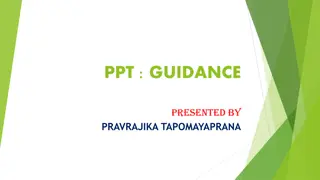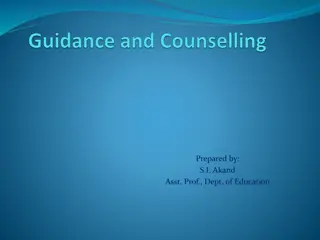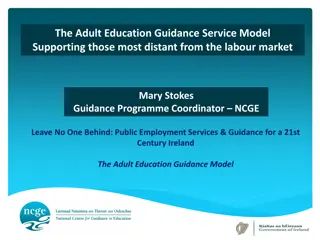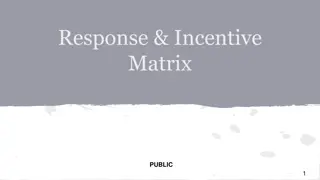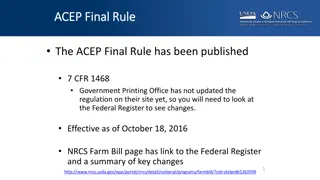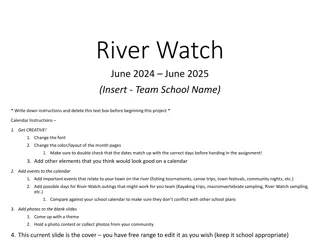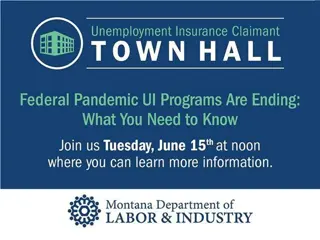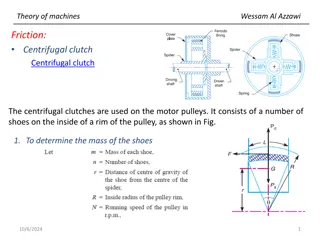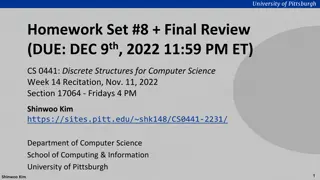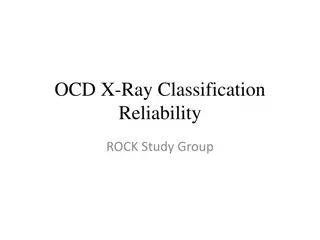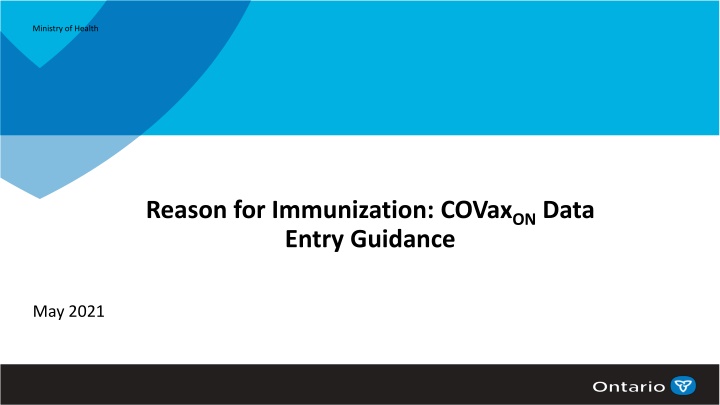
Data Entry Guidance for Reason for Immunization in COVaxON
This document provides guidance on data entry for the Reason for Immunization field in COVaxON, outlining eligibility criteria for receiving the COVID-19 vaccine. It includes recommendations for standardizing definitions, training, and quality assurance, endorsed by key ministry areas. Various categories for immunization reasons are detailed, reflecting the prioritization logic model.
Download Presentation

Please find below an Image/Link to download the presentation.
The content on the website is provided AS IS for your information and personal use only. It may not be sold, licensed, or shared on other websites without obtaining consent from the author. If you encounter any issues during the download, it is possible that the publisher has removed the file from their server.
You are allowed to download the files provided on this website for personal or commercial use, subject to the condition that they are used lawfully. All files are the property of their respective owners.
The content on the website is provided AS IS for your information and personal use only. It may not be sold, licensed, or shared on other websites without obtaining consent from the author.
E N D
Presentation Transcript
Ministry of Health Reason for Immunization: COVaxONData Entry Guidance May 2021
Context This document provides data entry guidance on the Reason for Immunization data field in COVaxON, which captures the eligibility criteria that a client meets to receive their COVID-19 vaccine. Changes to the RIM drop down in COVaxON Guidance on selection of RIM (logic model) Definitions & considerations The sector expressed a need to standardize Reason for Immunization (RIM) provincial data entry guidance, including clear value definitions, training and ongoing quality assurance. Public Health Ontario prepared a draft data entry technical guidance document for the reason for immunization data field in COVaxON for ministry consideration including: Principles for selecting a reason for immunization Default values with corresponding definitions Flow chart to assist with decision-making We have worked closely with key ministry areas (policy, operations, data analytics, IT) to review the guidance and update the information to capture all phases of the vaccine strategy within this briefing deck. We have also reached out to relevant ministries to validate definitions. The recommendations have been endorsed by the Executive Table on Vaccine Reporting and Dr. Williams. This information from PHO has been instrumental in providing the following go forward directions. The ministry is also working on data quality remediation for RIM to ensure the data in COVaxONmaps to this drop-down list. The recommended prioritization logic model and definitions will be an asset in this work as well. 2
Reason for Immunization to Support Phase 1-3 of the Vaccine Strategy Long Term Care: Resident Long Term Care: Healthcare Worker Long Term Care: Other Employee Long Term Care: Other Non-Employee Long Term Care: Essential Caregiver Retirement Home: Healthcare Worker Retirement Home: Resident Retirement Home: Essential Caregiver Retirement Home: Other Employee Retirement Home: Other Non-Employee ALC: Alternate Level of Care Patients in Hospitals Healthcare Worker Indigenous community Chronic Home Care Advanced Age: Community Dwelling Person with Priority Health Condition Caregiver of Person with Priority Health Condition Congregate Living: Resident Congregate Living: Staff Congregate Living: Essential Caregiver Agriculture: Temporary Foreign Worker- Congregate Setting Community at Greater Risk Agriculture or Farm Worker (not temp foreign worker) Food Manufacturing Worker Education Worker Childcare worker Essential workers cannot work from home Youth 12+ Age Eligible Population One list of reason for immunization and only one entry 1. Reason for Immunization selected should reflect the primary reason the client was vaccinated at the time of the first immunization event 2. The dropdown list is reordered to align with prioritization logic (as per slide 5) 3.
Reason for Immunization: Logic Model Principles In Phase 1 vaccination was prioritized for population groups and was predominantly sequential, setting-specific and/or reflected defined population groups In Phase 2, vaccination sequencing follows primary and secondary priority groups outlined in the Ministry of Health s COVID-19: Guidance for Prioritization of Phase 2 Populations for COVID-19 Vaccination. Within the primary and secondary priority groups, vaccine may be offered concurrently to population groups and sequencing may vary across and within PHUs. Setting (where a person works or lives) can be used to help determine the primary reason for vaccination Select only one reason for immunization Reason for immunization selected should reflect the primary reason the client was vaccinated at the time of the first immunization event Reason for Immunization is entered at each dose administered record. The reason should reflect the primary reason the client was vaccinated as per the priority logic model (see slide 5) The client record shows the most recent entered RIM. Therefore, RIM can be updated at the time of the second vaccination dose to more accurately reflect the primary reason the client was vaccinated Institution can be selected from any RIM value (therefore schools can be added for all children regardless of RIM) Institution currently reflect hospitals, LTCH, RH, Congregate settings and schools. The logic model takes into consideration Phase 1 through 3 in a single flow The logic model is to be used as a tool to help data recorders enter data inCOVaxON 4
Reason for Immunization Logic Model START HERE Select the most appropriate option: Long Term Care: Healthcare Worker Long Term Care: Resident Long Term Care: Essential Caregiver Long Term Care: Other Employee Long Term Care: Other Non-employee Retirement Home: Healthcare Worker Retirement Home: Resident Retirement Home: Essential Caregiver Retirement Home: Other Employee Retirement Home: Other Non- employee ALC: Alternate Level of Care Patients in Hospitals Is the client 7. An individual with a highest/high/ at-risk priority health condition or a caregiver of an individual with a highest or high risk priority health condition? No, proceed to box 9 8. An eligible individual in a community identified as a hot spot?* No 6. A resident, essential caregiver or staff of a seniors or high-risk congregate setting?* No Select Institution 1. A worker, essential caregiver or resident at a LTC Home or Retirement Home? (includes ALC patients with planned discharge to facility)? Yes Yes Yes Yes Select Select the most appropriate option: Person with Priority Health Condition Caregiver of Person with Priority Health Condition Select the most appropriate option: Congregate Living: Staff Congregate Living: Resident Congregate Living: Essential Caregiver Agriculture: Temporary Foreign Worker- Congregate Setting Community at Greater Risk No 2. A healthcare worker at another facility or in the community? Yes Select 10. An adolescent & youth age 12-25 that does not fit in any other preceding eligible priority population? Healthcare Worker 11. An individual age 26 to 79 that does not fit in any other eligible priority population? Select Institution No No No 9. An essential worker who cannot work from home and is one of the following: Yes Yes 3. Someone who identifies as Indigenous, First Nations, Inuit, Metis? Yes Select Select Indigenous community Select Youth 12+ Age Eligible Population No Yes, select Select Institution Yes 4. A recipient of chronic home health care? Select Chronic Home Care An agriculture worker or food manufacturing worker?* An education worker or a childcare worker? An essential worker who is not previously listed and cannot work from home?* No Yes Yes Yes Yes Select 5. An older adult aged 80+ years living in the community? Advanced Age: Community Dwelling Select the most appropriate option: Food Manufacturing Worker Agriculture or Farm Worker (not temp foreign worker) Select the most appropriate option: Education Worker Childcare Worker Select Essential Workers Cannot work from home No, proceed to box 6
Default Values and Definitions: Considerations Eligible Age Groups and the Pediatric Strategy Eligibility changes over the immunization program. As different age groups are prioritized for vaccination (i.e., they become eligible) they are to be included, where applicable, in the priority groups. Youth 12-25 may be part of these other groups as follows: *Essential Caregivers, LTC Other Non-Employee, LTC Other Employee, RH Other Non-Employee, RH Other Employee, Congregate Living Staff and Essential Workers who can not work from home can include age 16+ **Chronic Home Care, Indigenous Community, Congregate Living Resident, Person with Priority Health Condition, Community at Greatest Risk, Youth 12+ can include age 12+ Individuals who identify as Indigenous There is a flag on the client profile to confirm consent for data entry First Nations, M tis and Inuit elder care home or high-risk congregate living settings (e.g., healing and wellness centres, shelters) have been added to the institution list Indigenous community drop down will only capture Indigenous in the community. LTC/RH/Congregate Living default values with the link to institution will better capture this information for Indigenous. The total count for Indigenous in COVax could come from the client profile. 6
Reason for Immunization Default Values and Definitions Default Value Definition (For all LTC and RH you will also be asked to select the institution) Long Term Care: Resident An individual whose primary residence is in a long-term care home including First Nations Elder Care Home. Long Term Care: Healthcare Worker An individual who is employed or contracted to work in a long-term care home setting as a healthcare worker, who provides direct patient care services (e.g., physician, nurse practitioner, nurse, personal support worker, physiotherapist, dietician, occupational therapist, chiropodist). An individual who is employed or contracted to work in a long-term care home setting in non-direct patient care roles, who is frequently in the patient environment (e.g., cleaning, food services, administration, recreation, security, maintenance staff). An individual who is not employed or contracted to work in a long-term care home, but who is frequently in the patient environment (e.g. volunteer, spiritual care). An individual who has been designated by the resident and/or their substitute decision-maker and is visiting to provide direct care to the resident (e.g., supporting feeding, mobility, personal hygiene, cognitive stimulation, communication, meaningful connection, relational continuity). Includes family members, a privately hired caregiver or companion, translators. Long Term Care: Other Employee* Long Term Care: Other Non- Employee* Long Term Care: Essential Caregiver* Excludes: Any individual employed or contracted to work in LTC; other non-employees in LTC. Retirement Home: Resident An individual whose primary residence is in a retirement home. Retirement Home: Healthcare Worker An individual who is employed or contracted to work in a retirement home setting as a healthcare worker, who provides direct patient care services (e.g., physician, nurse practitioner, nurse, personal support worker, physiotherapist, dietician, occupational therapist, chiropodist). An individual who has been designated by the resident and/or their substitute decision-maker and is visiting to provide direct care to the resident (e.g., supporting feeding, mobility, personal hygiene, cognitive stimulation, communication, meaningful connection, relational continuity). Includes family members, a privately hired caregiver or companion, translators. Retirement Home: Essential Caregiver* Excludes: Any individual employed or contracted to work in RH; other non-employees in RH. An individual who is employed or contracted to work in a retirement home setting in non-direct patient care roles, who is frequently in the patient environment (e.g., cleaning, food services, administration, security, maintenance, recreation staff). An individual who is not employed or contracted to work in a retirement home, but who is frequently in the patient environment (e.g. volunteer, spiritual care). Patients who occupy a hospital bed but do not require the intensity of services provided in that care setting (e.g. waiting for LTC or home care). Select the institution the individual is currently in. Retirement Home: Other Employee* Retirement Home: Other Non- Employee* ALC: Alternate Level of Care Patients in Hospitals 7
Reason for Immunization Default Values and Definitions Default Value Definition (For all congregate living you will also be asked to select institution) Healthcare Worker A regulated health professional, staff member, contract worker (e.g., agency staff), student/trainee, essential caregiver, or volunteer currently working in a healthcare organization, including workers in non-direct patient care roles and frequently in the patient environment (e.g., cleaning, food services, administration, research, security, IT staff); or any worker providing health service or direct patient care services in a community setting (outside of a healthcare organization) (e.g. nurse providing care in school or home) as defined in . Excludes: Healthcare workers working in long-term care (LTC) or retirement homes (RH); other employees in LTC, RH and or congregate care settings; essential caregivers in LTC, RH or congregate care settings; other non-employees working in LTC and RH. Indigenous Community** Individuals in First Nations, M tis and Inuit communities, including urban Indigenous populations. Excludes: Indigenous adults who are healthcare workers, all individuals whose primary residence is a First Nations, M tis and Inuit elder care home or high-risk congregate living setting (e.g., healing and wellness centres, shelters). Chronic Home Care** Individual recipients of chronic home health care. Excludes: Indigenous adults who receive chronic home health care. Advanced Age: Community Dwelling Older adults age 80+ years who live in the community (i.e., in a private dwelling outside of an LTC, RH or institution). Excludes: Older adult recipients of chronic home health care; older Indigenous adults. An individual whose primary residence is a high-risk congregate setting (e.g. group homes, shelters, supportive housing, correctional facilities, wellness centre), which refers to residential facility where a high-risk client population lives or stays overnight and use shared spaces (e.g., common Congregate Living: Resident** sleeping areas, shared bathrooms, kitchens and dining.For a list of high-risk congregate living settings see COVID-19: Guidance for Prioritization of Phase 2 Populations for COVID-19 Vaccination An individual who is staff member, contract worker (e.g., agency staff), student/trainee, essential caregiver, or volunteer currently working in a high- risk congregate setting. Congregate Living: Staff* Congregate Living: Essential Caregiver* Agriculture: Temporary Foreign Worker- Congregate Setting An individual who is an essential caregiver for a person residing in specific a high-risk congregate settings. Workers employed under the federal government s Temporary Foreign Worker programming including (but not limited to) the Seasonal Agriculture Worker Program and Agriculture stream that lives in a congregate setting. 8
Reason for Immunization Default Values and Definitions Default Values Definitions (For all hotspots will be asked to select FSA, for school students you will be asked to select school institution) Person with Priority Health Condition** An individual with a health condition that places them at an increased risk of severe outcomes from COVID-19. For a list of health conditions see COVID-19: Guidance for Prioritization of Phase 2 Populations for COVID-19 Vaccination. A primary essential caregiver for a person with a priority health condition (applies to the highest-risk and high-risk health condition groups only), requiring regular and sustained assistance with personal care and activities of daily living. For a list of health conditions see Person with Priority Health Condition. Caregiver of Person with Priority Health Condition* Individuals (18 years+ ) living in neighborhoods and communities disproportionally impacted by COVID-19, also known as Hot Spot Communities. MOH will provide PHUs with Forward Sortation Areas (FSA) for communities identified as hot spots. Farm owners or workers employed by a farming operation or by companies that directly support a farming operation (e.g., veterinarian, input supply, livestock trucking). A worker employed by a business conducting operations around the primary or secondary processing or distribution of agriculture or food products. An elementary or secondary school educator, staff member, contract worker (e.g., supply teacher), or student/trainee currently working in a public or private school, including workers in non-direct teaching roles (e.g., administration, custodial, food service staff, school bus drivers). Community at Greater Risk ** Agriculture or Farm Worker (not temp foreign worker) Food Manufacturing Worker Education Worker Excludes: post-secondary education workers (e.g. college, university, private training institute); childcare workers. Childcare Worker Licensees, employees and students (18+) on an educational placement who interact directly with children in licensed child care centres and in authorized recreation and skill building programs. Licensed home child care and in-home service providers, employees of a home child care agency and students (18+) on an educational placement who interact directly with children in a licensed home child care setting. A frontline worker who provides in-person, public-facing essential goods and services in sectors deemed essential to the ongoing functioning of the economy (e.g. justice and society service, critical infrastructure, agriculture, agri-food, essential goods and supply chain). For a list of essential workers who cannot work from home see COVID-19: Guidance for Prioritization of Phase 2 Populations for COVID-19 Vaccination Essential Workers- Cannot work from home* Excludes: Healthcare workers as defined. Adolescent and youth age 12 to 25 including those attending primary or secondary school, post secondary school in fall 2021 or international students not represented in any other priority population above. Please enter the school the child or youth is entering in fall 2021. Youth 12+ Age Eligible Population Eligible individuals 26-79 years, as they become eligible, who are not represented in any other priority population 9








